Objectives
Goals for the bedside shift report (BSR) project
- Create an opportunity for patient and family to participate in care delivery.
- Create a team to identify areas of improvement.
- Standardize the process of BSR.
- Find ways to implement nursing BSR strategy.
- Direct implementation of BSR.
There are four main types of nursing reports described in literature: a written report, a tape-recorded method, a verbal face-to-face report conducted in a private setting, and face-to-face bedside hand-off, also called a Bedside Shift Report.
Currently, the latter method is a significant topic of research in nursing. Although it is not new, studies into its effectiveness have only started appearing recently, and most of them agree that switching to bedside report is beneficial to everyone: hospital staff, patients, and their families alike.
The ultimate goal for this project is to create an opportunity for the patient and his or her family to participate in care delivery by implementing this practice. The steps necessary to reach this goal are…
The steps are taken directly from the project paper.

What is Bedside Shift Report (BSR)?
- A shift report done at the patient’s bedside.
- Occurs between the outgoing nurse, incoming nurse, patient, and patient’s family (if permitted).
- Participants are introduced to one another.
- Done in language everyone present can understand.
- Report and assessment of the patient and room.
- Verbal report using the SBAR+T format.
- Review the incoming nurse’s tasks.
- The patient and their family are encouraged to participate.
- The patient’s and family’s needs and concerns can be identified.
A bedside shift report is, as the name implies, a nurse’s shift report done in person, at the patient’s bedside.
It involves the two nurses changing shifts, the patient him- or herself, and his or her family. For this practice’s purposes, the patient defines who the family is and whether they are allowed to be present.
First of all, the outgoing nurse makes sure everyone is introduced to one another, and uses language that everyone present can understand — no medical jargon that can confuse the patient.
As a part of the report, the nurses conduct focused assessment of the patient and the room’s safety.
Next, the outgoing nurse conducts a verbal reports. He or she should use the SBAR (Situation, Background, Assessment, Recommendation) with an additional step: always thank the patient.
Then the incoming nurse’s tasks are reviewed.
The BSR practice focuses on communication between the two nurses and the patient, who is encouraged throughout the process to participate, raise concerns and ask questions to clear up any misunderstandings. If any family is present, they are also encouraged to join, if the patient allows.
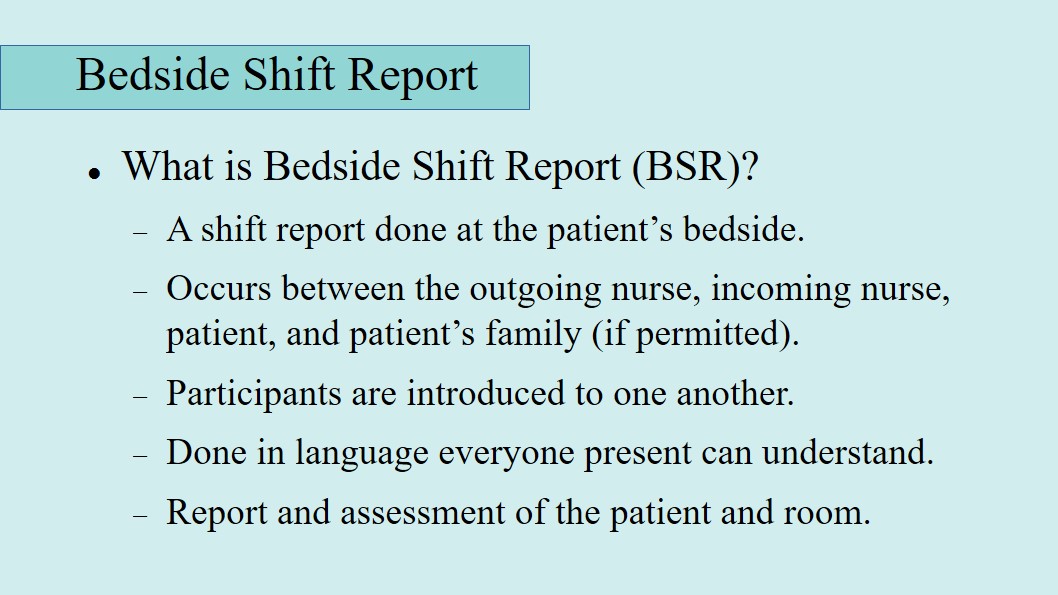
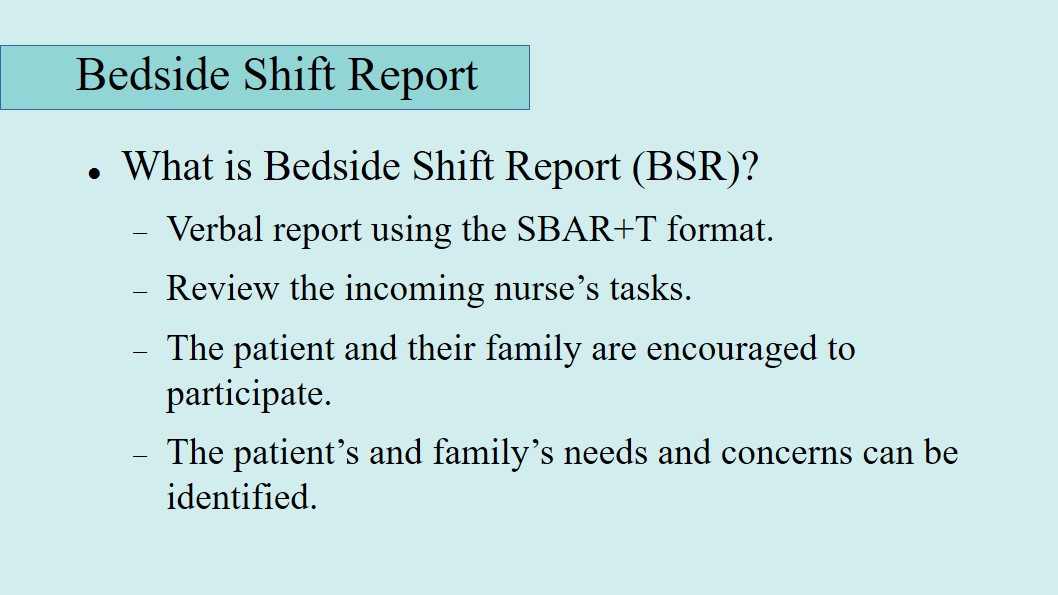
Patient benefits of BSR
- Significant improvements to patient safety: fewer sentinel events during shift change (Ofori-Atta, 2015).
- Patient falls significantly reduced (Sand-Jecklin & Sherman, 2014).
- Assessment of the patient allows to check surgical wounds, pressure ulcers, other physical issues (Ofori-Atta, 2015).
- Medications are verified at BSR, reducing medication errors (Sand-Jecklin & Sherman, 2014).
- General patient satisfaction is improved (Dorvil, 2018).
- Patients can clarify information, better set their expectations, and clear misunderstandings (Gregory, Tan, Tilrico, Edwardson, & Gamm 2014).
- Patients get a clearer understanding of their care (Gregory et al., 2014).
- Patients feel better informed and more engaged in their care (Dorvil, 2018).
The patient is the central focus of a health care provider. Previous studies have noted that a significant portion of sentinel events happen during the shift change, causing negative outcomes that could have been prevented. Since BSR is done in the patient’s presence, events lake patient falls can be responded to immediately or prevented. Furthermore, as the process includes an assessment of the patient as part of the SBAR+T model, any physical issues can be spotted, and medication pumps verified for accuracy.
As a consequence of a more personal report process that includes them, patients’ satisfaction increases. The two-way communication with the nurses allows them to ask any questions and voice any concerns they may have. Thus empowered, they can clear up any misunderstandings or offer feedback and suggestions, becoming better informed and engaged in their care. Furthermore, getting more opportunities to interact with nurses allows them to build trust and feel safer overall.
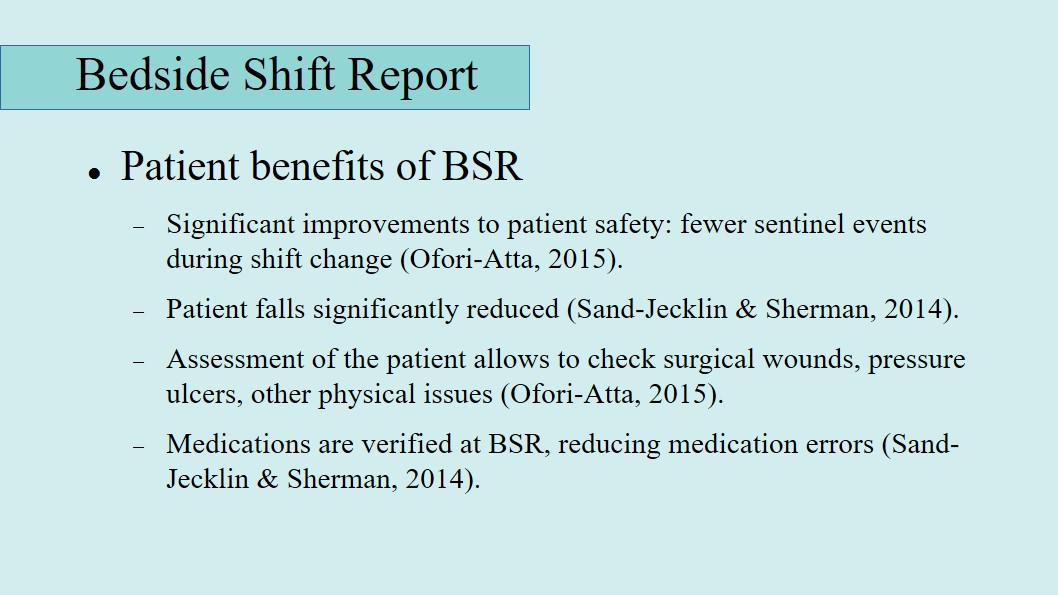
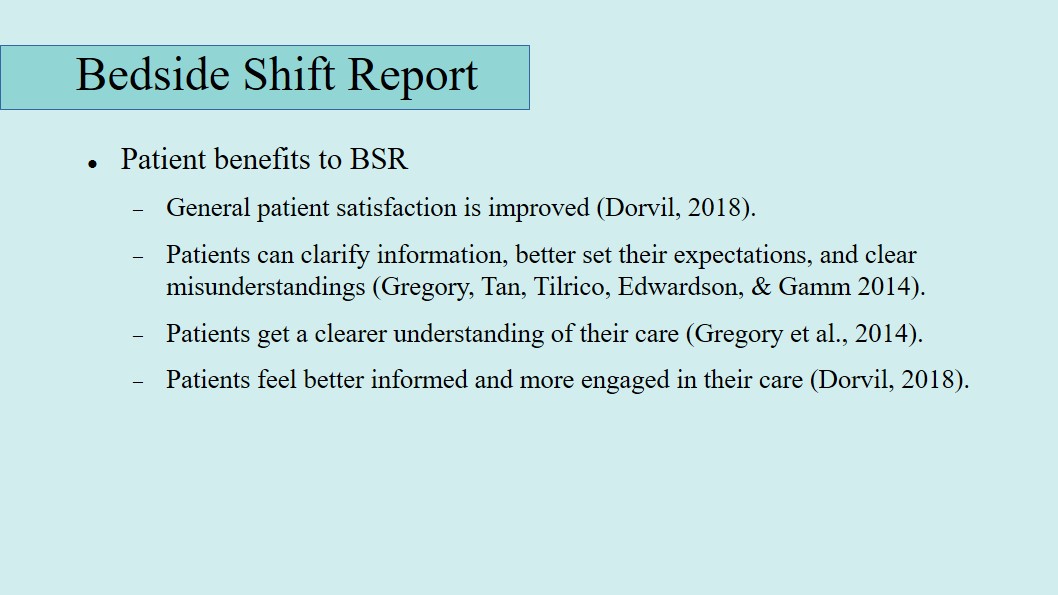
Nurse benefits of BSR
- Shorter report times mean less overtime, causing less stress and saving up to $143,520 in expenses (Dorvil, 2018).
- Oncoming nurse can begin direct patient care sooner (Gregory et al., 2014).
- Better assignment prioritization due to better communication (Ofori-Atta, 2015).
- Greater report efficiency and accuracy compared to other report methods (Dorvil, 2018).
- Improved nurse-nurse socialization and emotional support (Gregory et al., 2014).
- Improved teamwork, coordination and collaboration (Gregory et al., 2014).
- Increased ability to answer physicians’ questions at the beginning of the shift (Sand-Jecklin & Sherman, 2014).
- Less patient call-light use (Sand-Jecklin & Sherman, 2014).
- Increased accountability (Ofori-Atta, 2015).
- More opportunities for mentoring, coaching, and networking (Gregory et al, 2014).
- Nurses can visualize the patient and build rapport (Gregory et al., 2014).
- Fewer delays and real-time assessment lead to better nurse satisfaction (Gregory et al., 2014).
Nurses benefit from the implementation of BSR, as well. Studies have shown that this method takes less time than the other three shift report methods. This means less overtime is accrued — in one study, over a hundred thousand dollars was saved in overtime expenses. For the same reason, the oncoming nurse can begin direct patient care sooner, and thanks to the SBAR framework, they can prioritize their assignments better. Finally, direct communication is more efficient and accurate than reading or listening to a report.
Since the incoming and outgoing nurse communicate directly during their report, they get an opportunity to socialize, tell stories, and provide emotional support to one another. Thanks to that, they collaborate and coordinate their activities better, becoming a stronger team.
Some studies have even noted that nurses can answer physicians’ questions better at the beginning of their shift, as they have more hands-on experience with the patient and are directly informed of any issues that may be present. Others have noted that patients are less likely to use the call-light after implementation of BSR.
Working closely together during the report also improves accountability, as the incoming and outgoing nurse can corroborate, verify, and support each other’s statements. It also means they can assist one another through mentoring, coaching, or networking.
Seeing the patient and talking to them directly allows nurses to build trust and rapport with them, once again contributing to those feelings of satisfaction and safety.
Ultimately, as face-to-face bedside reports are so much more efficient than other methods, being conducted in real-time, general nurse satisfaction tends to increase.

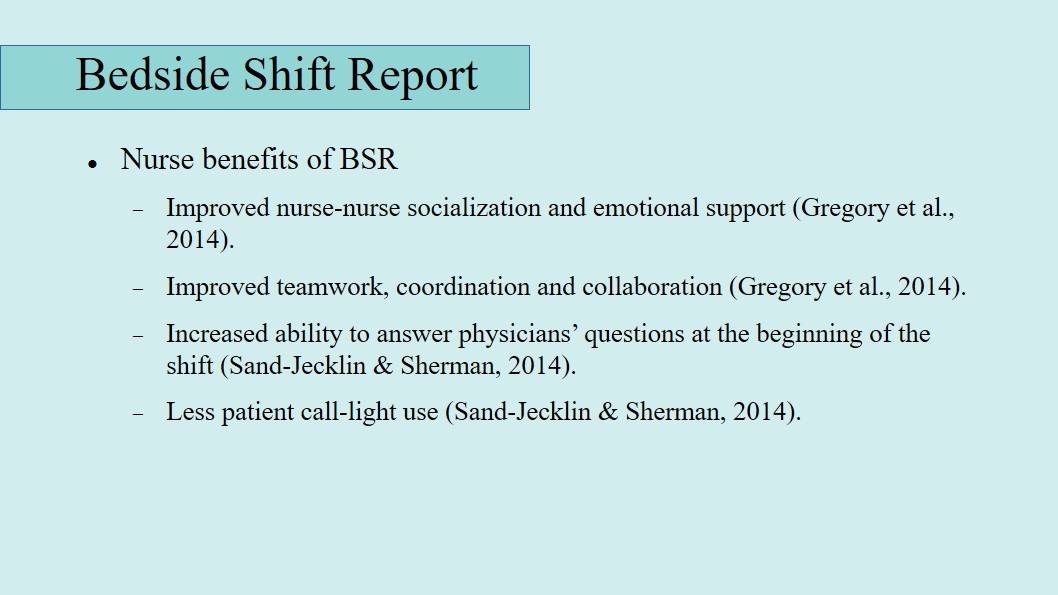
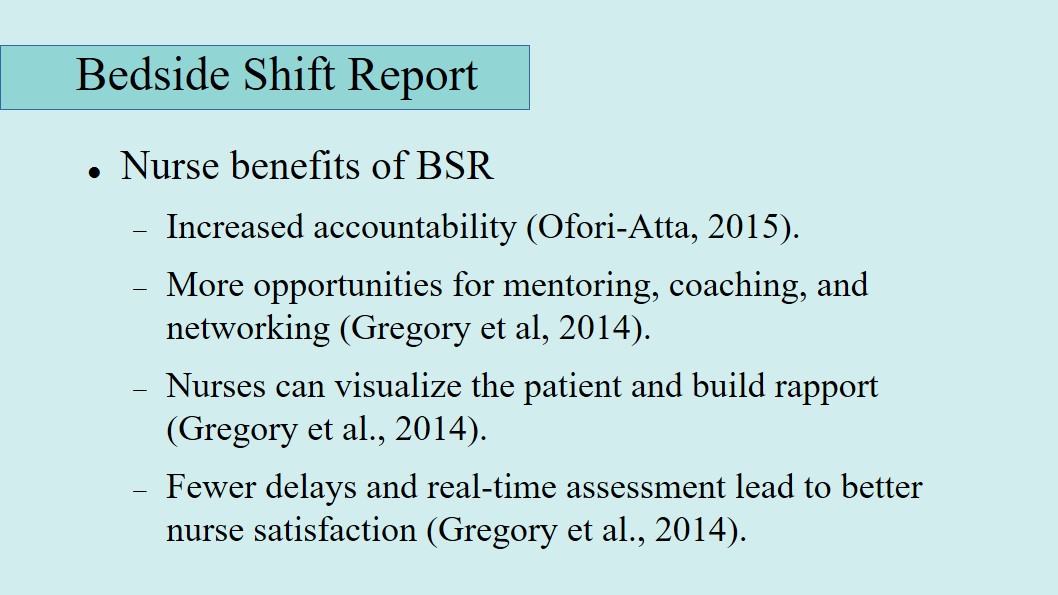
Drawbacks and concerns
- Privacy concerns: nurses have to report potentially sensitive information in semiprivate rooms (Gregory et al., 2014).
- Patients were less concerned about privacy (Sand-Jecklin & Sherman, 2014).
- BSR does not violate HIPAA (Agency for Healthcare Research and Quality, 2017).
- Redundancy, medical jargon, or hearing about their condition tiring and anxiety-inducing to some patients (Sand-Jecklin & Sherman, 2014).
- Some nurses found BSR more stressful than other report methods (Sand-Jecklin & Sherman, 2014).
- Patients can ask questions that require a long answer or cannot be answered (Dorvil, 2018).
- Some nurses perceive the report time as longer. This was not supported by overtime data (Sand-Jecklin & Sherman, 2014).
- Time-consuming to fully implement (Dorvil, 2018).
- There are several issues related to sustainability (Dorvil, 2018).
- Some outcomes rebounded to after a short-term increase (Sand-Jecklin & Sherman, 2014).
- Standardization seems to alleviate these issues (Dorvil, 2018).
However, several drawbacks and concerns have been established with BSR.
Privacy is a somewhat obvious concern. After all, giving a report, talking about potentially sensitive medical issues in a semiprivate room or accidentally disclosing information the patient has not been made aware of can be an issue. AHRQ has stated that as long as reasonable precautions have been taken, BSR does not violate HIPAA. Most patients, meanwhile, don’t seem to share such concerns. Some found the disturbance of the report tiring, however.
On the nurses’ side, some found talking in front of patients uncomfortable and BSR more stressful. Furthermore, some studies noted concerns that the report can be prolonged by patients asking difficult questions that either require an extended explanation or cannot be answered at the time. However, this is simply a matter of training: one can delay answering such questions until later. Possibly related to these concerns, some nurses claimed that the report took longer than before. Actual overtime statistics were consistently lower across studies.
The most significant issues with BSR are related to the practice’s sustainability. Although most studies show consistently and significantly positive outcomes, one survey collected data 3 and 13 months after BSR’s implementation to measure its long-term effects. Although its results were still positive after a year, most metrics at that point were significantly lower than after the 3-month period, and not significantly higher than they were pre-implementation. The authors of this survey suggest that a lack of standardization of the report process is to blame for this rebound, which is not a problem inherent to the practice, and can therefore be fixed.
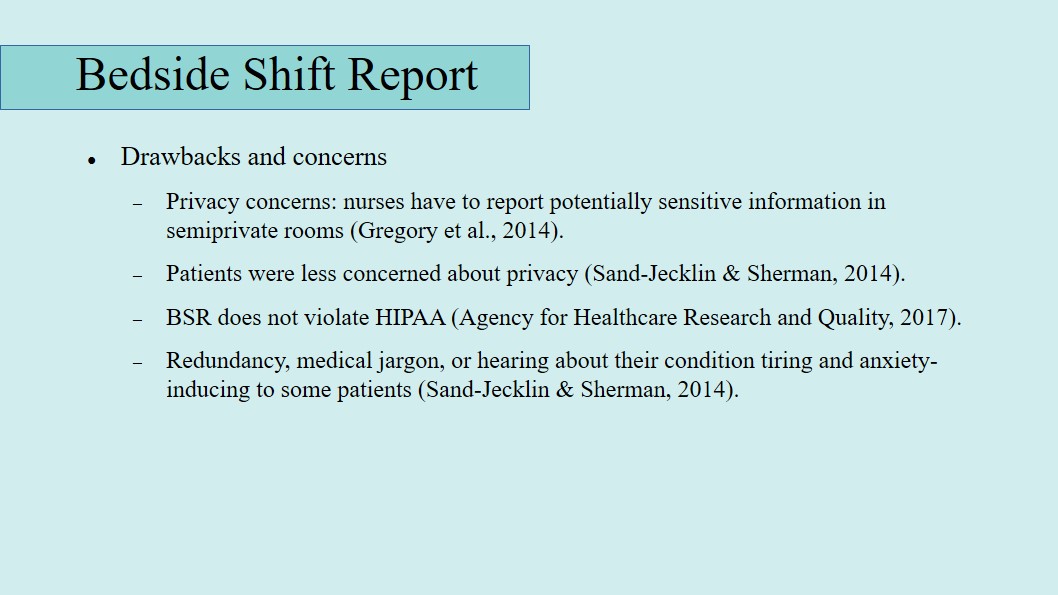
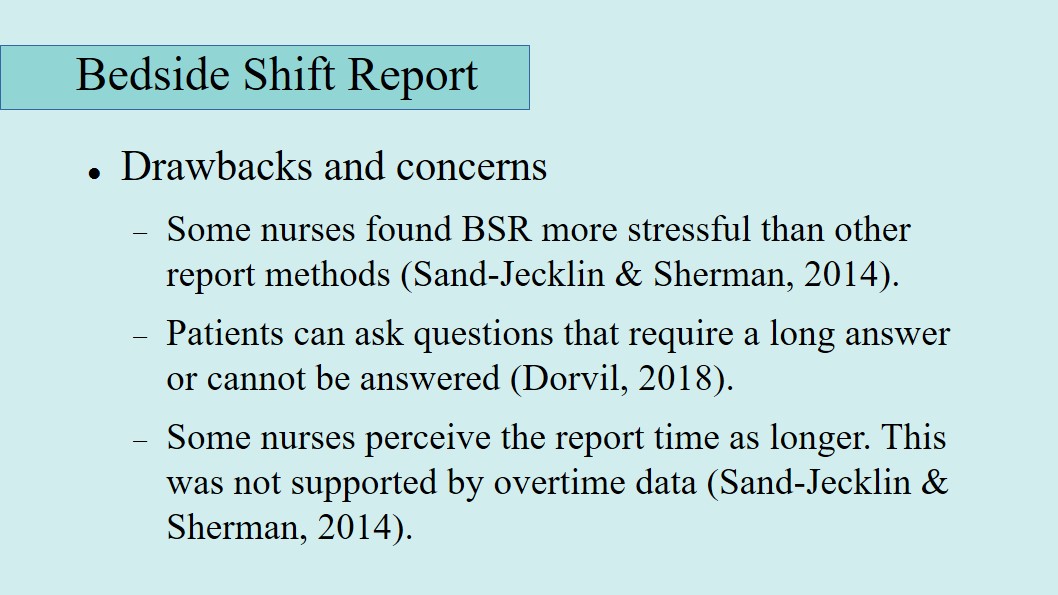
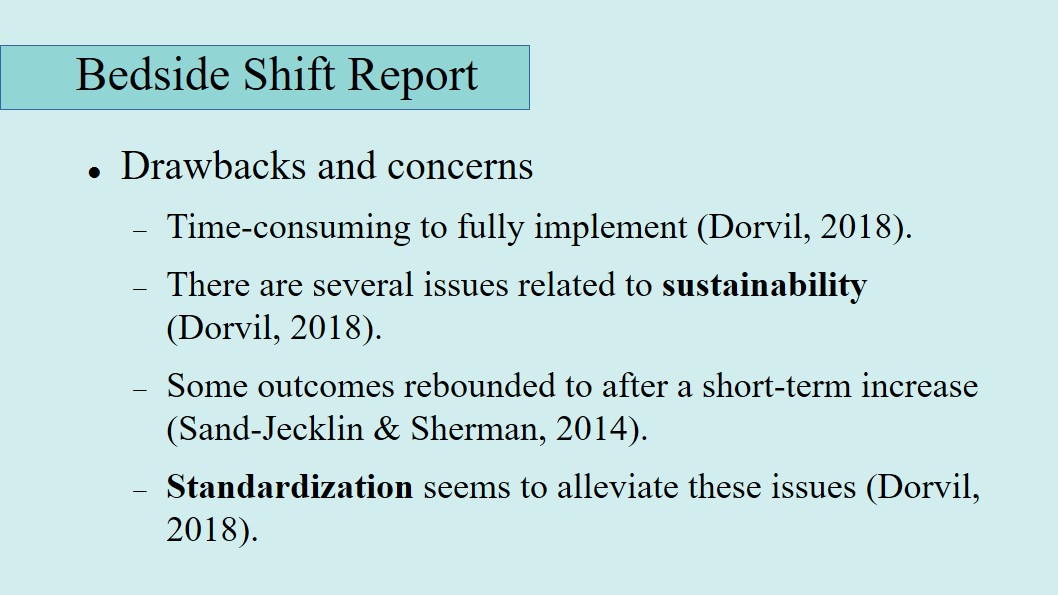
To summarize
- Saves time, down from 40 to 10 minutes in one case (Ofori-Atta, 2015).
- Saves money (Dorvil, 2018).
- Benefits both nurses and patients (Gregory et al., 2014).
- Disadvantages mostly related to training and employee/leader buy-in (Dorvil, 2018).
As demonstrating, implementing bedside shift reports is ultimately an improvement with few drawbacks.
It saves time. Studies show that it takes 15 minutes less, on average, than previous report methods. In one case, thanks to utilizing the SBAR framework, report times were reduced to 10 minutes.
It saves money because nurses are more likely to end their shift on time.
Both nurses and patients report higher levels of satisfaction and safety after the implementation of BSR.
Although there are disadvantages, they are primarily related to employee training and standardization of the process.
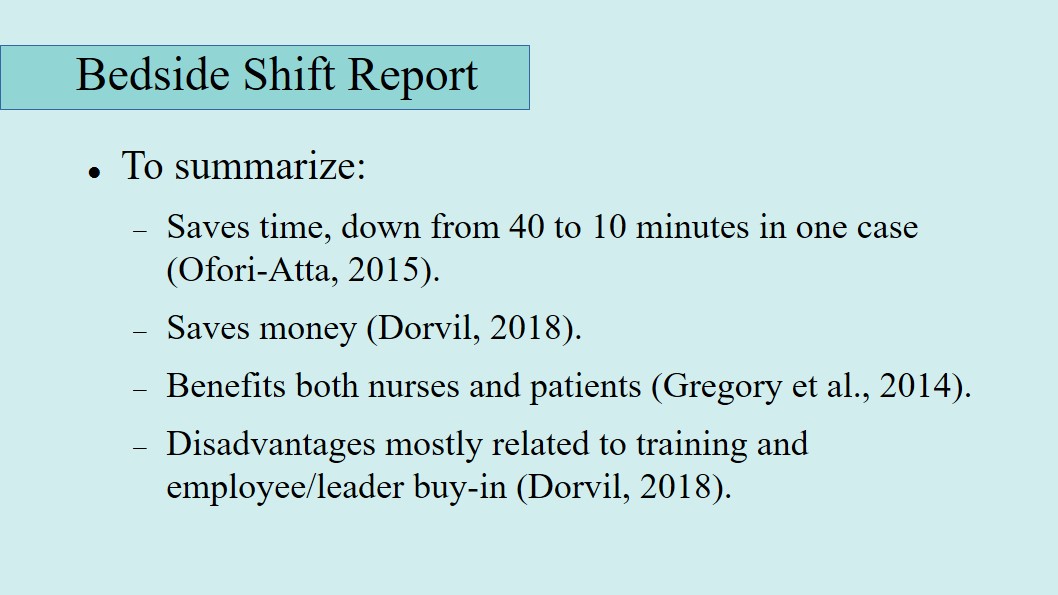
How to implement BSR
Dorvil (2018) suggests following Everett Rogers’ five-step approach:
- Knowledge: introduce the idea to staff and educate them.
- Persuasion: discuss advantages and disadvantages, build positive attitude towards the new practice.
- Decision: form a leadership group, establish theoretical framework and practical goals.
- Implementation: evaluate and modify the practice as necessary.
- Confirmation: monitor nurses’ attitudes, reinforce the practice.
The article by Dorvil reports overcoming the difficulties in the implementation of BSR by using Everett Rogers’ five-step approach.
Ultimately, the implementation of BSR requires a long-term approach and an in-depth study of the organizational environment. As it is a complex and multi-faceted process, establishing a multidisciplinary team is crucial to its success. Since training addresses major concerns and emphasized critical points of the practice, the key element for the successful adoption is the support from the nurse managers and staff.
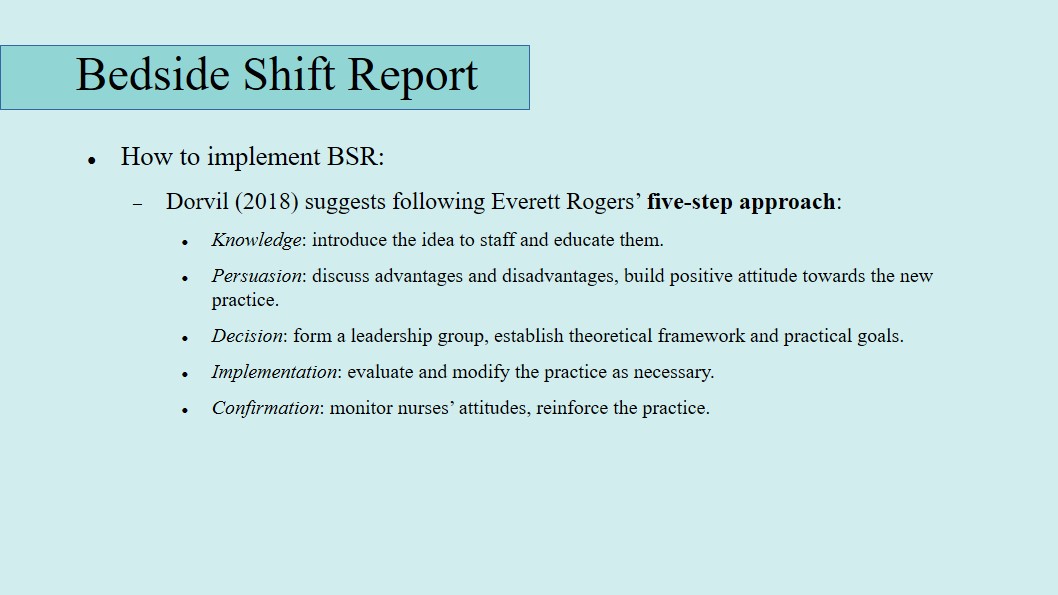
References
Agency for Healthcare Research and Quality. (2017). Nurse bedside shift report. Implementation handbook. Web.
Dorvil, B. (2018). The secrets to successful nurse bedside shift report implementation and sustainability. Nursing Management (Springhouse), 49(6), 20-25. Web.
Gregory, S., Tan, D., Tilrico, M., Edwardson, N., & Gamm, L. (2014). Bedside shift reports. What does the evidence say? JONA: The Journal of Nursing Administration, 44(10), 541-545. Web.
Ofori-Atta, J. (2015). Bedside shift report: implications for patient safety and quality of care. Nursing, 45(8), 1-4. Web.
Sand-Jecklin, K., & Sherman, J. (2014). A quantitative assessment of patient and nurse outcomes of bedside nursing report implementation. Journal of Clinical Nursing, 23(19-20), 2854-2863. Web.